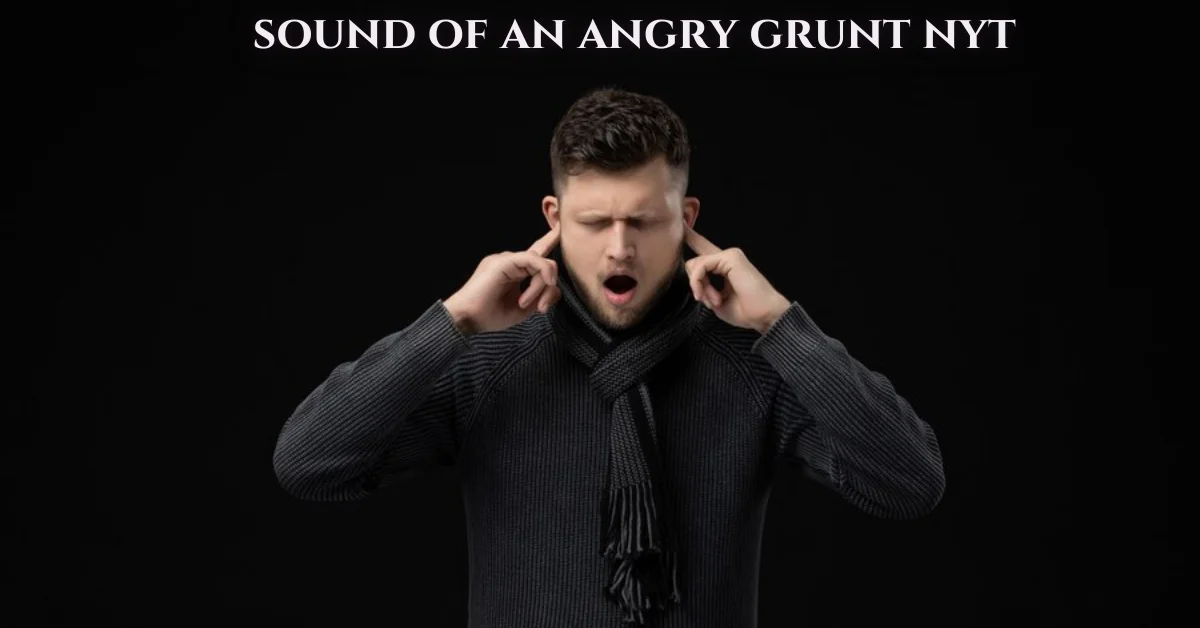Introduction to the Sound of an Angry Grunt
Have you ever been on the receiving end of an angry grunt? That low, guttural sound can send shivers down your spine, igniting a mix of confusion and concern. The sound of an angry grunt NYT carries weight beyond mere annoyance; it’s a primal expression that cuts through language barriers and taps into our shared human experience. This unrefined vocalization isn’t just noise—it has deep roots in evolution and communication. As we dive deeper into this fascinating phenomenon, you’ll discover how much power lies within those simple sounds. Prepare to unravel the intriguing layers behind the sound of an angry grunt!
ALSO READ: Ennuifans: Channeling Ennui into Art and Community!
The Evolutionary Purpose of Grunting
Grunting has deep roots in human evolution. It is a primal form of expression that predates language. Early humans relied on grunts to communicate emotions and intentions, facilitating social bonding.
The sound served as an immediate signal during conflicts or threats. An angry grunt conveyed frustration without the need for complex words. This instinctual response helped our ancestors navigate dangerous environments by alerting others to their emotional state.
Moreover, it played a role in group dynamics. Grunts could unify or divide groups based on intensity and context. Understanding these sounds became essential for survival, allowing individuals to gauge potential aggression levels among peers.
Even today, the evolution of this non-verbal communication reflects our innate instincts. The sound resonates not just with anger but also with underlying feelings of fear or vulnerability. Grunting remains a vital part of how we express ourselves beyond spoken language.
Different Types of Angry Grunts and Their Meanings
Angry grunts come in various forms, each carrying its own weight of emotion. A low, guttural grunt often signals frustration or annoyance. It’s the sound of someone grappling with their temper yet holding back from a full-blown outburst.
On the other hand, a quick and sharp grunt might indicate immediate irritation. This type can be heard when someone is abruptly interrupted or faced with an unwelcome surprise. The intensity speaks volumes without uttering a single word.
Then there’s the drawn-out grunt – deep and resonant. This one usually reflects deeper dissatisfaction or disappointment. It lingers in the air, emphasizing just how fed up someone feels.
Each variation communicates different layers of anger and can set off alarms for those nearby to tread carefully, understanding that emotions are simmering beneath the surface. Recognizing these nuances enriches our grasp of non-verbal cues in social interactions.
The Psychological Effects of Grunting on Others
The sound of an angry grunt can evoke a range of reactions in those who hear it. For many, it triggers an instinctive sense of tension and alertness. The guttural tone often signals discomfort or discontent, compelling listeners to pay attention.
Psychologically, grunting can create a visceral response. It may instigate feelings of fear or anxiety, especially if the grunt comes from someone perceived as threatening. This non-verbal cue taps into our primal instincts, prompting us to assess potential danger.
Conversely, some individuals might find humor in an exaggerated grunt. It can diffuse tension when used playfully among friends but carries weight when associated with genuine anger.
Understanding these nuances helps navigate social dynamics effectively—whether at home or work—and illustrates how such simple sounds carry profound psychological implications for human interaction.
How to Respond to an Angry Grunt?
When faced with the sound of an angry grunt, your first instinct might be to react defensively. However, it’s essential to pause and assess the situation.
Take a moment to gauge the environment. Is this grunt directed at you or is it simply an expression of frustration from someone else? Understanding context can help shape your response.
If it’s aimed at you, maintain calmness in your demeanor. Acknowledge their feelings without escalating tension. Simple phrases like “I see you’re upset” can work wonders.
Body language matters too. Keep an open posture and avoid crossing your arms; this signals that you’re approachable rather than confrontational.
Listening actively plays a crucial role as well. Sometimes all they need is someone who hears them out without judgment.
Responding thoughtfully not only diffuses anger but also fosters better communication moving forward.
The Power of Non-Verbal Communication Through Grunting
Grunting is more than just a sound; it’s a powerful form of non-verbal communication. When words fall short, an angry grunt can express frustration or displeasure instantly.
This guttural expression resonates on primal levels. It transcends language barriers, conveying emotions that often remain unspoken. The tone, pitch, and intensity of a grunt provide context to the listener.
People instinctively understand these sounds in social settings. A low growl might signal annoyance, while a sharper exhale could indicate immediate anger. These nuances create rich layers of meaning.
Moreover, grunting taps into our evolutionary heritage. Early humans relied heavily on body language and vocalizations for survival and connection within groups.
In today’s world, understanding this silent yet impactful form of expression can enhance interpersonal interactions significantly. Recognizing the subtleties behind an angry grunt allows for deeper emotional intelligence in relationships.
Conclusion: Embracing and Understanding the Angry Grunt
The sound of an angry grunt carries a weight that transcends mere noise. It encapsulates raw emotion, often serving as an immediate expression of discomfort or frustration. By embracing and understanding this sound, we can unlock deeper insights into human behavior and communication.
Grunting is not just an instinctual response; it has evolved to convey complex emotions in a primal way. Recognizing the nuances behind these sounds allows us to navigate social interactions more effectively. We learn what certain grunts signify and how they impact those around us.
Additionally, responding appropriately to someone’s grunt can pave the way for better relationships. Acknowledging their feelings without judgment shows empathy, while also encouraging open dialogue when tensions cool down.
As we become more attuned to these non-verbal cues, we enhance our ability to connect with others on a fundamental level. Embracing the sound of an angry grunt isn’t about accepting aggression; it’s about fostering understanding amid conflict.
By appreciating this unique aspect of communication, we cultivate compassion and awareness towards ourselves and others—turning potentially volatile situations into opportunities for growth and connection.
ALSO READ: Ninjabytezone.com/: The Go-To Hub for Gamers and Tech Fans
FAQs
What is “Sound of an Angry Grunt NYT”?
The “Sound of an Angry Grunt NYT” refers to an exploration of the emotional, psychological, and evolutionary roots behind angry grunting, as detailed in a New York Times feature.
Why do people grunt when they’re angry?
Grunting when angry is an instinctual response rooted in human evolution, used to communicate frustration or aggression without words.
How does an angry grunt affect others psychologically?
An angry grunt often triggers feelings of tension or alertness in listeners, activating a primal sense of caution and awareness.
Are there different types of angry grunts?
Yes, angry grunts can vary in tone and intensity, from low, simmering grunts indicating frustration to sharp, immediate grunts signaling sudden irritation.
How should one respond to an angry grunt?
The best response to an angry grunt is to stay calm, acknowledge the person’s emotions, and avoid escalating the tension by remaining approachable and open.











